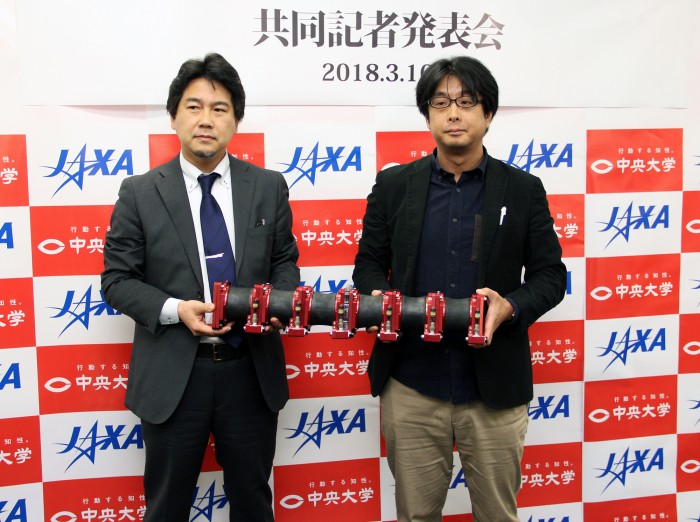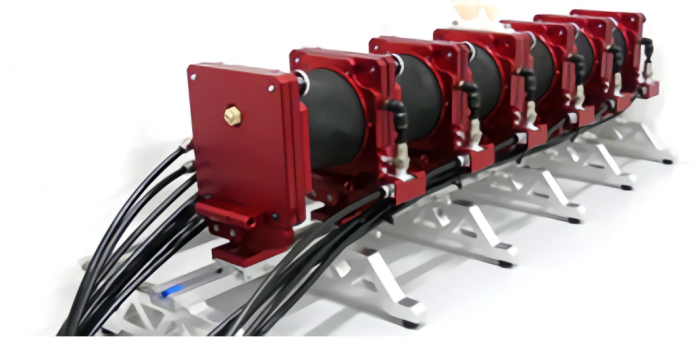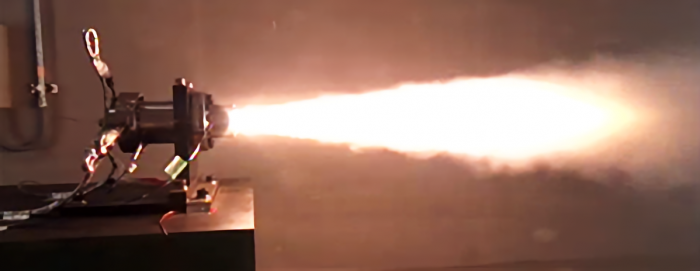Photo from a joint press conference ©Chuo University
A research group led by Professors Taro Nakamura and Yasunosuke Yamada (Chuo University) and Professor Hiroto Habu (ISAS/JAXA) aims to radically redesign the manufacturing process for solid rocket propellants using artificial muscle (*1) and biomimetic design.
They have succeeded in mixing solid rocket propellants and on-ground test burns using a peristaltic mixing conveyor developed in this research. This is a world-first fuel manufacturing device of this type.
Peristaltic mixing conveyor ©Chuo University
Countries around the world are actively competing to develop rockets with low launch costs. In the case of solid-fuel rockets, one factor in high launch costs is the cost of producing the propellant, which makes up the majority of the vehicle weight. When manufacturing the solid fuel currently used in the Epsilon rocket and others, fuel is mixed using a metal vessel and stirring blades (*2). There are many barriers to reducing costs in this manufacturing method, including maintenance and management of manufacturing equipment and process control, making it difficult to proceed with investigations of new manufacturing methods.
The research group led by Professor Nakamura aims to radically redesign the manufacturing process for solid rocket propellants, using artificial muscle (*1) and a design that mimics the peristaltic motion of the human large intestine. They have successfully produced solid rocket fuel using a peristaltic mixing conveyor developed in their research.
This device consists of nonmetallic soft actuators (*3) using "axially reinforced artificial muscle fibers" (*4) originally developed by Professor Nakamura, providing a structurally safe system configuration that can be driven by compressed air. This system conveys fuel using movements similar to the peristaltic motion of the human large intestine, namely, contractions and relaxations. In this way, solid fuel is safely and continuously mixed without the need for stirring blades as it is transported to the rocket body.
To demonstrate that this device can produce solid fuel for rockets, on 26 December 2017 the group carried out experiments using this device for mixing and conveyance of fuel materials with a practical composition at the Akagi Factory of Japan Carlit Co., Ltd. Furthermore, on 23 February 2018, solid fuel manufactured using this equipment was loaded into a rocket motor for testing, and an on-ground test burn was conducted, confirming that the fuel was practical for use in rockets.
On-ground test burn ©Chuo University
As a result, they succeeded in world-first production of solid fuel using a soft actuator and automatic conveyance. This is a major step toward production and automatic transport of solid rocket fuel.
This research was undertaken after adoption as "Research and development of manufacturing technologies for solid propellant from consumer technologies (artificial muscles)," a Space Technology Information Infrastructure Development Research and Development Project by the Ministry of Economy, Trade, and Industry.
(*1) Artificial muscle
Artificial muscle is a type of actuator (a mechanism that converts input energy from pneumatic, hydraulic, or electrical devices into physical movements such as rotational or rectilinear motion) developed to mimic the physical functions of natural muscles. There are various types of artificial muscle, such as those using piezoelectricity, shape memory alloys, electrostatics, or pneumatics. References here are to pneumatic artificial muscle.
(*2) Mixed using a metal vessel and stirring blades
Solid propellant is generally manufactured in a batch system in which kneading is performed using a planetary mixer (a mixing device that rotates metal blades in a metal bowl to stir), with manual transport performed separately. Reliability must be guaranteed by ensuring everything from fuel lot management to manufacturing process management.
(*3) Soft actuators
Soft actuators are actuators that use flexible materials and those that generate flexible movements. Among these, we define artificial muscles as those that aim to simulate the physical functions of natural muscles.
(*4) Axially reinforced artificial muscle fibers
Axially reinforced artificial muscles are structures that contain glass roving fibers in the axial direction of a rubber tube, and are actuators that expand in the radial direction to generate axial-direction contractions driven by a pneumatic supply. Using proprietary technology from Chuo University, these muscle fibers can generate four times the force generated by conventional McKibben-type artificial muscles at the same pressure.



